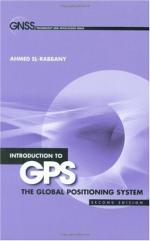|
This section contains 1,064 words (approx. 4 pages at 300 words per page) |

|
The Global Positioning System (GPS) is undoubtedly one of the most practical of all satellite projects. It provides navigation and location information to other satellites, commercial airliners, cruise ships, land surveyors, map makers, bicyclists, and hikers. GPS is based on a very simple theoretical principle that is complex to achieve practically.
The basic principle behind GPS is the measurement of distance—in this case, the distance between satellites and receivers on the ground. The satellites transmit a radio message. Their distance from the receiver can be easily calculated using the speed at which the message travels (the speed of light) and the time it takes to complete its travel. By comparing the time the signal was sent and received, the distance from the satellite can be calculated as: Distance = Speed (C) × Time Difference. If the satellite were directly overhead, the time for the signal...
|
This section contains 1,064 words (approx. 4 pages at 300 words per page) |

|



